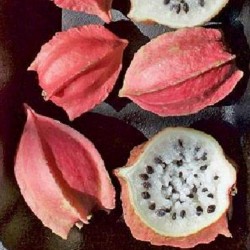Menu
-
MenuVissza
- Home
-
Kategóriák
-
-
Kategóriák
-
Zöldségmagok
-
Fajták országonként
- Fajták Örményország
- Fajták BiH
- Fajták Horvátországból
- Fajták Franciaországból
- Varieties from Germany
- Varieties from Greece
- Varieties from Hungary
- Fajták India
- Varieties from Italy
- Fajták Japánból
- Fajták Észak-Macedónia
- Varieties from Peru
- Varieties from Russia
- Varieties from Serbia
- Szlovéniából származó fajták
- Varieties from Spain
- Varieties from Thailand
- Fajták Törökország
- Varieties from USA
- Paradicsommag
- Kukoricamag
- Tök család magjai
- Babcsalád
- Uborka mag
- Paprikamag
- Sárgarépa család
- Hagyma család
- Saláta magok
- Burgonya család
- Káposzta család
- Retekmag
- Cékla család
- Görögdinnye magok
- Dinnye magok
- Karfiolmag
- Napraforgó család
-
Fajták országonként
- Gyümölcsmag
- Chili paprika magok
- Gyógynövénymagok
- Hegymászó növények magjai
- Fák - cserje - magok
- Pálma mag
- Díszes fűmagok
- Dohánymagok
-
Zöldségmagok
-
-
-
-
- ÚJ TERMÉKEK
- Fiók létrehozása
- Szállítás - fizetés
- FAQ
Last Product Reviews
Out of the two seeds, one germinated and the other one was dead and floatin...
By
 Riikka H on 07/03/2024
Riikka H on 07/03/2024
Verified Purchase
384 termék található.
331-345 / 384 elem mutatása

A növény ellenáll a hidegnek és a fagynak
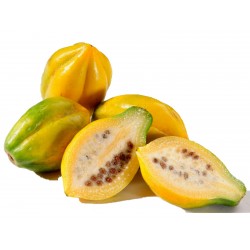
Hegyi papaya magok...
Ár
3,00 €
(SKU: V 22 VP)
Seeds Gallery EU,
5/
5
<h2><strong>Hegyi papaya magok (Vasconcellea pubescens)</strong></h2>
<h2><span style="color: #ff0000;"><strong>Ár csomag 5 magot.</strong></span></h2>
<p>A hegyi papaya (Vasconcellea pubescens), más néven hegyi mancs, papayuelo, chamburo vagy egyszerűen "papaya" a Vasconcellea nemzetség egyik faja, Dél-Amerika északnyugati részén található Andokban őshonos Kolumbia déli irányától Chile közepéig, jellemzően 1500–3000 méter (4900–9 800 láb).<br><br>A nőstény növények nagy mennyiségű sárga gyümölcsöt teremnek, amelyeket hagyományosan italok készítésére használnak, főzve és fogyasztva is.<br><br>A Vasconcellea pubescens egy örökzöld pachycaul cserje vagy kis fa, amely 10 méter magasra nő.<br><br>A gyümölcs 6–15 cm hosszú és 3–8 cm széles, öt széles hosszanti bordával az aljától a csúcsáig; zöld, sárga vagy narancs érlelődik. A gyümölcspép ehető, hasonló a papajához, és általában zöldségként főzik. Nyersen is fogyasztják.<br><br>Carica pubescens néven is ismert.<br><br>A Carica pubescens a legalkalmasabb meleg, mérsékelt éghajlatra, ahol nincs szélsőséges meleg vagy hideg. </p>
V 22 VP


Szuper ritka Carica papaya...
Ár
5,95 €
(SKU: V 22 GM)
Seeds Gallery EU,
5/
5
<h2 class=""><strong>Szuper ritka Carica papaya Gabon Dinnye mag</strong></h2>
<h2><span style="color: #ff0000;"><strong>Ár csomag 5 magot.</strong></span></h2>
<p>Ritka papaya fajta, amelyet Közép-Afrikában termesztenek. A növények nagy mennyiségű, szinte gömb alakú gyümölcsöt teremnek, amely kiváló ízű és állagú.<br><br>Mivel ez a papaya nem nő magasra (mini), kiválóan alkalmas virágcserepekben való termesztésre. Már a vetés után egy évvel meghozza gyümölcsét. </p>
V 22 GM (5 S)


A növény ellenáll a hidegnek és a fagynak
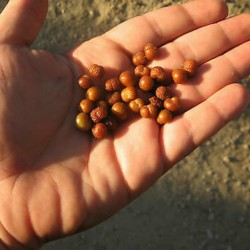
Vad ribizli magvak (Grewia...
Regular price
1,75 €
-0,01 €
Ár
1,74 €
(SKU: V 90 GF)
Seeds Gallery EU,
5/
5
<h2 class=""><strong>Vad ribizli magvak (Grewia flava)</strong></h2>
<h2><span style="color: #ff0000;"><strong>Ár csomag 10 magot.</strong></span></h2>
A Grewia flava szívós cserje vagy kis fa, 2–4 m magas. A fiatal ágak szürke kérge, amelyet általában vastag növekedésű, de meglehetősen rövid szőr borít, hajlamos sötétszürke színűvé válni, és annál simabb lesz, minél idősebb lesz a fa; ez a szárakon is észrevehető. A szürkészöld levelek váltakozva helyezkednek el, finom szőrszálak borítják, és úgy tűnik, hogy a levelek alsó oldalán a zöld világosabb árnyalatú. A csúcs (a levelek hegye) lekerekített, míg a pereme fogazott. A levél alapjáról három feltűnő ér jellemzi ezt a fát; 2 mm hosszú levélszár is nagyon észrevehető.<br><br>A virágok elágazó fejekben jelennek meg nyár elejétől ősz közepéig (októbertől márciusig), és átmérőjük körülbelül 10-15 mm.<br><br>A 2 karéjos gyümölcs átmérője ± 8 mm, zöld, érve vörösesbarnává válik. A gyümölcsfa világosnak tűnik, a keményfa barna, finom textúrájú.<br><br>A leveleket és gyümölcsöket a hazai állomány élvezi, valamint a vadállatok, például a Kudu és a Zsiráf, valamint a legkülönfélébb madarak.<br><br>
<h3><strong>A Grewia flava felhasználja</strong></h3>
A brandybush kérgét gyakran használták kötél gyártásához. A gyümölcsöket továbbra is egyfajta pálinka vagy „mampoer” fokozására használják. Az édes C-vitaminnal dúsított gyümölcs önmagában is élvezhető. A szárított gyümölcsből hagyományosan zabkását készítettek, miután lisztté dolgozták fel. A fa kemény és finom szemcsés, és botokhoz használják. A korábbi vadászok, akárcsak a San közösség, íjaikat és nyilukat ennek a növénynek az ágaiból készítették.<br><br>
<h3><strong>Vetés Grewia flava</strong></h3>
Ez a növény a legjobban jól vízelvezetett talajban és teljes napsütésben nő. A ház kertjében aszfaltozott területek közelében meglehetősen biztonságos ültetni, látva, hogy nincs agresszív gyökérzete. A rengeteg virág miatt sikeresen felhasználható a kert fókuszpontjaként.<br><br>A növény meglehetősen szívós és ellenáll a fagynak. A növény megalakulásakor kerülni kell a túlöntözést.<br><br>A legjobb szaporítási módszer a magvak. Válasszon friss magokat, tisztítsa meg és szárítsa meg őket jól szellőző, árnyékos helyen. Áztassa a magokat legalább 24 órán át vízben, a kezdeti víznek meleg víznek kell lennie. Vesse a magokat palántatálcákba, és takarja le körülbelül 5 mm mélyen; csak folyami homokot használjon táptalajként. Helyezze a tálcákat meleg, védett helyre. Ne hagyja kiszáradni a táptalajt. A sikeres csírázáshoz állandó nedvességszintet kell fenntartani. A magvak csírázása általában következetlen, körülbelül 50–70% -os sikerarányt figyeltek meg. A palántákat ki lehet ültetni konténerekbe, amikor elérik a 2 leveles stádiumot.
V 90 GF

- -0,01 €

Ez a termék a legkeresettebb termék
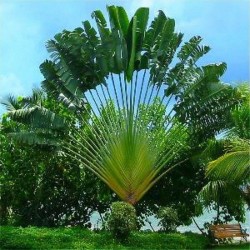
Travellers Palm Seeds
Ár
2,25 €
(SKU: PS 3)
Seeds Gallery EU,
5/
5
<h2 class=""><strong>Travellers Palm Seeds (Ravenala Madagascariensis)</strong></h2>
<h2><span style="color: #ff0000;"><strong>Price for Package of 3 seeds.</strong></span></h2>
<p>A fast-growing palm that forms huge leaves (up to 20ft long in its tropical home) arranged in a fan shape. However, in the UK it is easily kept as a beautiful indoor banana. For those of you who like to know such things the name comes from two unusual features - firstly the fan-shaped leaf structure tends to grow East-West and secondly when cut, the leaves provide refreshment to the (desperate!) thirsty traveler.</p>
<div></div>
<div>
<table cellspacing="0" cellpadding="0" border="1">
<tbody>
<tr>
<td colspan="2" width="100%" valign="top">
<p>Sowing Instructions</p>
</td>
</tr>
<tr>
<td valign="top" nowrap="nowrap">
<p>Propagation:</p>
</td>
<td valign="top">
<p>Seeds</p>
</td>
</tr>
<tr>
<td valign="top" nowrap="nowrap">
<p>Pretreat:</p>
</td>
<td valign="top">
<div>carefully remove the blue residue of the fruit</div>
<div>soak for 2 days in tepid water at 25-30 °C (77-86 °F)</div>
</td>
</tr>
<tr>
<td valign="top" nowrap="nowrap">
<p>Stratification:</p>
</td>
<td valign="top">
<p>0</p>
</td>
</tr>
<tr>
<td valign="top" nowrap="nowrap">
<p>Sowing Time:</p>
</td>
<td valign="top">
<p>all year round</p>
</td>
</tr>
<tr>
<td valign="top" nowrap="nowrap">
<p>Sowing Depth:</p>
</td>
<td valign="top">
<p class="">1 cm</p>
</td>
</tr>
<tr>
<td valign="top" nowrap="nowrap">
<p>Sowing Mix:</p>
</td>
<td valign="top">
<p>sow the seeds in 1 pot with soil, cover the pot to minimise evaporation</p>
</td>
</tr>
<tr>
<td valign="top" nowrap="nowrap">
<p>Germination temperature:</p>
</td>
<td valign="top">
<p>keep at 25-30 °C (77-86 °F)</p>
</td>
</tr>
<tr>
<td valign="top" nowrap="nowrap">
<p>Location:</p>
</td>
<td valign="top">
<p>bright + keep constantly moist not wet</p>
</td>
</tr>
<tr>
<td valign="top" nowrap="nowrap">
<p>Germination Time:</p>
</td>
<td valign="top">
<p>1 month to 1 year, very erratic</p>
</td>
</tr>
<tr>
<td valign="top" nowrap="nowrap">
<p>Watering:</p>
</td>
<td valign="top">
<p>Water regularly during the growing season</p>
</td>
</tr>
<tr>
<td valign="top" nowrap="nowrap">
<p> </p>
</td>
<td valign="top">
<p><br />Copyright © 2012 Seeds Gallery - Saatgut Galerie - Galerija semena. All Rights Reserved.</p>
</td>
</tr>
</tbody>
</table>
</div>
<script src="//cdn.public.n1ed.com/G3OMDFLT/widgets.js"></script>
PS 3 (3 S)

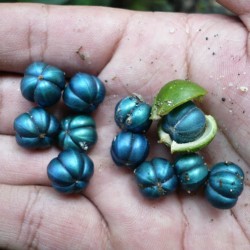
Bastard Hogberry mag...
Ár
3,50 €
(SKU: V 55 MN)
Seeds Gallery EU,
5/
5
<h2 class=""><strong>Bastard Hogberry mag (Margaritaria nobilis)</strong></h2>
<h2><span style="color: #ff0000;"><strong>Ár csomag 5 magot.</strong></span></h2>
<strong>Dekoráció minden udvarhoz és kerthez.</strong><br>A Margaritaria nobilis lombhullató fa, nyitott, gömb alakú koronával, általában 8-16 méteresre nő. Az egyenes, hengeres fájdalom átmérője 40-70 cm lehet. A növény néha örökzöld lehet.<br><br>A fát időnként vadonból szüretelik helyi fa felhasználásra, és erdősítésre is alkalmas. Ez egy dekoratív fa, és tereprendezési projektekben használható.<br><br>A Margaritaria nobilis, más néven Bastard hogberry egy olyan fa, amely Mexikóban, Közép-Amerikában, Dél-Amerikában és Nyugat-Indiában található meg.<br><br>A gyümölcs világos irizáló kék, amely egy összetett felületszerkezet eredménye, amely zavarja a fényhullámokat.<br><br>Virágzik a napon és az árnyékban.<br><br>Mérsékelt, gyorsan növő fa.<br>A növények szinte egész évben virágozhatnak és gyümölcsöt teremhetnek.<br>A kétkamrás fajokat, hímeket és nőstényeket egyaránt meg kell termeszteni, ha gyümölcsöt és magot akarsz szerezni.<br><br>Magas csírázásra általában számítani lehet, de a magok néhány héten belül kicsíráznak. Ha a palánták 4-5 cm magasak, tegyük őket külön tartályokba, és körülbelül 4-5 hónappal később készen álljanak az ültetésre.
V 55 MN


Ayurveda növény

Gyógy vagy fűszernövény
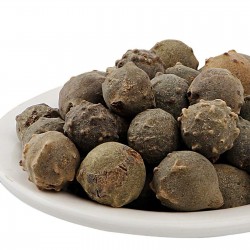
Aleppo tölgymag (Quercus...
Ár
9,95 €
(SKU: T 90)
Seeds Gallery EU,
5/
5
<h2><strong>Aleppo tölgymag (Quercus infectoria)</strong></h2>
<h2><span style="color: #ff0000;"><strong>Ár csomag 5 magot.</strong></span></h2>
A Quercus infectoria, az Aleppo tölgy, olyan tölgyfaj, amely golyókat hordoz, amelyeket Ázsiában évszázadok óta hagyományosan használnak gyógyszeresen. Manjakani az a név, amelyet Malajziában használnak a gallsra; ezeket évszázadok óta használják a bőr lágyítására, valamint a fekete festék és tinta készítésére. Indiában a gallokat majuphalnak hívják sok más név mellett.<br><br>A Quercus infectoria egy kis fa, amely Görögországban és Kis-Ázsiában őshonos, egy-két méter magas (négy-hat láb). A szár görbe, cserjés megjelenésű, sima és élénkzöld levelekkel, 3–4 cm (1–1,5 hüvelyk) hosszú rövid levélnyélen. A levelek nyersen nyálkásak, lekerekítettek, simaak, tövükön egyenlőtlenek, felül pedig fényesek.<br><br>A gélek a Quercus infectoria fa fiatal ágain merülnek fel, amikor az epés darazsak elszúrják a tölgyfát, és lárváikat lerakják. Hullámos megjelenésűek.<br><br>A Quercus infectoria felhasználható pörköltek sűrítőjeként, vagy gabonafélékkel keverve kenyér készítéséhez.<br><br>Az indiai hagyományos orvoslásban Majuphal néven is ismert manjakanit fogporként, valamint a fogfájás és az ínygyulladás kezelésében alkalmazták.<br><br>Az úgynevezett "Aleppo-tannin" az Aleppo-tölgyfa gallérokból nyert csersav, amely egyedülálló kémiai tulajdonságokkal rendelkezik, amelyek nélkülözhetetlenek az immunocitokémiában markerként használt aranyszolok (kolloidok) előállításához.<br><br>Manapság az epekivonat-kivonatokat széles körben használják a gyógyszeriparban, az élelmiszer- és takarmány-adalékanyagok, a színezékek, a tinták és a kohászat területén is.<br><br>Majuphal Manjakani az egyik legerősebb természetes gyógynövény az ayurvéda területén. Népszerű a szöveti feszesítő hatása miatt, és nem sokkal a születése után védőgyógyszerként használják a csecsemők számára. Majuphal Manjakanit tartják a legjobb gyógymódnak a hüvelyi vagy méhsejtesés, rendellenes méhvérzés, rendellenes hüvelyváladék és leucorrhoea ellen.<br><br>Majuphal Manjakani a húgyúti fertőzésért, Majuphal Manjakani segít a húgyúti fertőzések enyhítésében. Összehúzó tulajdonsága segít a vizeletcsatornák fertőzésének leküzdésében, a szövetek károsodásainak gyógyításán és a hüvelyi bőr és szövetek egészségének megújításán kívül. Belsőleg történő fogyasztása más gyógynövényekkel együtt ajánlott, hogy hatékony legyen, de összehúzó tulajdonsága miatt ez a legjobb megoldás a külső tisztításra, hogy megszabaduljon a hüvelyi fekélyektől és szöveti károsodásoktól.<br><br>Majuphal Manjakani Használja a hüvely meghúzására, Majuphal Manjakani sok felhasználási és egészségügyi előnnyel jár a nők számára. Bőr- és szövetszűkítő tulajdonsággal rendelkezik. Majuphal Manjakanit tartják a legjobb gyógymódnak a hüvelyi vagy méhsejtesés, rendellenes méhvérzés, rendellenes hüvelyváladék, leucorrhoea ellen. A mosásápolási rutinhoz használt paszta vagy por alakú oldat formájában történő alkalmazás helyi alkalmazásként segíti a szövetek gyógyulását és a prolapsus állapotok gyors leküzdését. Más gyógynövényekkel együtt használják, és szülés után nőknek adják a méh falának rugalmasságának helyreállításához. Természetes összehúzó tulajdonsága helyreállítja a hüvely egészségét, hangulatát és erélyét, ami jobb és élvezetesebb szexet, valamint nőstény érzelmek és élvezet fokozódását eredményezi mind a nő, mind a párja számára.<br><br>Majuphal Manjakani úgynevezett „gyógynövény-varázslat” gazdag tannint tartalmaz a hüvelyi izmok, az A- és C-vitamin, a kalcium, a fehérje feszesítésére, valamint összehúzó elemet tartalmaz a hüvelyváladékot okozó baktériumok eltávolítására, a sűrűség növelésére, és ez segít megelőzni a további hüvelyi öregedés, amely a gyermekvállalásból, az életkorból, a szexuális partnerekből az évek során és az általános egészségi állapotból ered.<script src="//cdn.public.n1ed.com/G3OMDFLT/widgets.js"></script>
T 90


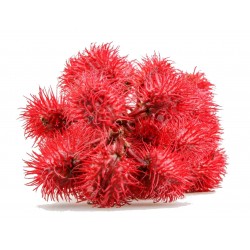
Castor Bean Seeds (Ricinus...
Ár
1,85 €
(SKU: MHS 125)
Seeds Gallery EU,
5/
5
<h2 class=""><strong>Castor Bean Seeds (Ricinus Communis)</strong></h2>
<h2><span style="color: #ff0000;"><strong>Price for Package of 15 seeds.</strong></span></h2>
<p><i style="font-size: 14px;"><b>Ricinus communis</b></i><span style="font-size: 14px;">, the</span><span style="font-size: 14px;"> </span><b style="font-size: 14px;">castor bean</b><span style="font-size: 14px;"> </span><span style="font-size: 14px;">or</span><span style="font-size: 14px;"> </span><b style="font-size: 14px;">castor oil plant</b><span style="font-size: 14px;">,</span><span style="font-size: 14px;"> </span><span style="font-size: 14px;">is a species of</span><span style="font-size: 14px;"> </span><span style="font-size: 14px;">perennial</span><span style="font-size: 14px;"> </span><span style="font-size: 14px;">flowering plant</span><span style="font-size: 14px;"> </span><span style="font-size: 14px;">in the</span><span style="font-size: 14px;"> </span><span style="font-size: 14px;">spurge</span><span style="font-size: 14px;"> </span><span style="font-size: 14px;">family,</span><span style="font-size: 14px;"> </span><span style="font-size: 14px;">Euphorbiaceae</span><span style="font-size: 14px;">. It is the sole species in the</span><span style="font-size: 14px;"> </span><span style="font-size: 14px;">monotypic</span><span style="font-size: 14px;">genus</span><span style="font-size: 14px;">,</span><span style="font-size: 14px;"> </span><i style="font-size: 14px;"><b>Ricinus</b></i><span style="font-size: 14px;">, and</span><span style="font-size: 14px;"> </span><span style="font-size: 14px;">subtribe</span><span style="font-size: 14px;">,</span><span style="font-size: 14px;"> </span><b style="font-size: 14px;">Ricininae</b><span style="font-size: 14px;">. The evolution of castor and its relation to other species are currently being studied using modern genetic tools.</span><span style="font-size: 14px;"> </span><span style="font-size: 14px;">It reproduces with a mixed pollination system which favors selfing by</span><span style="font-size: 14px;"> </span><span style="font-size: 14px;">geitonogamy</span><span style="font-size: 14px;"> </span><span style="font-size: 14px;">but at the same time can be an out-crosser by</span><span style="font-size: 14px;"> </span><span style="font-size: 14px;">anemophily</span><span style="font-size: 14px;"> </span><span style="font-size: 14px;">(wind pollination) or</span><span style="font-size: 14px;"> </span><span style="font-size: 14px;">entomophily</span><span style="font-size: 14px;"> </span><span style="font-size: 14px;">(insect pollination).</span></p>
<div>
<p>Its<span> </span>seed<span> </span>is the castor bean, which, despite its name, is not a true<span> </span>bean. Castor is indigenous to the southeastern<span> </span>Mediterranean Basin,<span> </span>Eastern Africa, and India, but is widespread throughout tropical regions (and widely grown elsewhere as an ornamental plant).<sup id="cite_ref-Phillips_5-0" class="reference">[5]</sup></p>
<p>Castor seed is the source of<span> </span>castor oil, which has a wide variety of uses. The seeds contain between 40% and 60% oil that is rich in<span> </span>triglycerides, mainly<span> </span>ricinolein. The<span> </span>seed<span> </span>also contains<span> </span>ricin, a<span> </span>water-soluble<span> </span>toxin, which is also present in lower concentrations throughout the plant.</p>
<p>An unrelated plant species,<span> </span><i>Fatsia japonica</i><span> </span>(false castor oil plant), is similar in appearance but is from Japan.</p>
<h2><span class="mw-headline" id="Nomenclature">Nomenclature</span></h2>
<p>The name<span> </span><i>Ricinus</i><span> </span>is a<span> </span>Latin<span> </span>word for<span> </span>tick; the seed is so named because it has markings and a bump at the end that resemble certain ticks. The genus<span> </span><i>Ricinus</i><span> </span><sup id="cite_ref-6" class="reference">[6]</sup><span> </span>also exists in zoology, and designates insects (not ticks) which are parasites of birds; this is possible because the names of animals and plants are governed by different<span> </span>nomenclature codes.<sup class="noprint Inline-Template Template-Fact">[<i><span title="This claim needs references to reliable sources. (October 2017)">citation needed</span></i>]</sup></p>
<p>The common name "castor oil" probably comes from its use as a replacement for<span> </span>castoreum, a perfume base made from the dried<span> </span>perineal glands<span> </span>of the<span> </span>beaver<span> </span>(<i>castor</i><span> </span>in Latin).<sup id="cite_ref-7" class="reference">[7]</sup>It has another common name,<span> </span><b>palm of Christ</b>, or<span> </span><i>Palma Christi</i>, that derives from castor oil's reputed ability to heal wounds and cure ailments.</p>
<h2><span class="mw-headline" id="Description">Description</span></h2>
<p><i>Ricinus communis</i><span> </span>can vary greatly in its growth habit and appearance. The variability has been increased by breeders who have selected a range of cultivars for leaf and flower colours, and for oil production. It is a fast-growing,<span> </span>suckering<span> </span>shrub<span> </span>that can reach the size of a small tree, around 12 m (39 ft), but it is not<span> </span>cold hardy.</p>
<p>The glossy<span> </span>leaves<span> </span>are 15–45 cm (5.9–17.7 in) long, long-stalked, alternate and palmate with five to twelve deep lobes with coarsely toothed segments. In some varieties they start off dark reddish purple or bronze when young, gradually changing to a dark green, sometimes with a reddish tinge, as they mature. The leaves of some other varieties are green practically from the start, whereas in yet others a pigment masks the green color of all the<span> </span>chlorophyll-bearing parts, leaves, stems and young fruit, so that they remain a dramatic purple-to-reddish-brown throughout the life of the plant. Plants with the dark leaves can be found growing next to those with green leaves, so there is most likely only a single gene controlling the production of the pigment in some varieties.<sup id="cite_ref-8" class="reference">[8]</sup><span> </span>The stems and the spherical, spiny seed capsules also vary in pigmentation. The fruit capsules of some varieties are more showy than the flowers.</p>
<div class="thumb tright">
<div class="thumbinner"><img alt="" src="https://upload.wikimedia.org/wikipedia/commons/thumb/2/23/Castor_oil_plant_seeds.jpg/220px-Castor_oil_plant_seeds.jpg" width="220" height="129" class="thumbimage" />
<div class="thumbcaption">
<div class="magnify"></div>
The green capsule dries and splits into three sections, forcibly ejecting seeds</div>
</div>
</div>
<p>The flowers lack petals and are unisexual (male and female) where both types are borne on the same plant (monoecious) in terminal<span> </span>panicle-like<span> </span>inflorescences<span> </span>of green or, in some varieties, shades of red. The male flowers are numerous, yellowish-green with prominent creamy<span> </span>stamens; the female flowers, borne at the tips of the spikes, lie within the immature spiny capsules, are relatively few in number and have prominent red<span> </span>stigmas.<sup id="cite_ref-Brickell_9-0" class="reference">[9]</sup></p>
<p>The fruit is a spiny, greenish (to reddish-purple)<span> </span>capsule<span> </span>containing large, oval, shiny, bean-like, highly poisonous seeds with variable brownish mottling. Castor seeds have a warty appendage called the<span> </span>caruncle, which is a type of<span> </span>elaiosome. The caruncle promotes the dispersal of the seed by ants (myrmecochory).</p>
<h2><span class="mw-headline" id="Medicinal_uses">Medicinal uses</span></h2>
<p>Castor oil<span> </span>has many uses in medicine and other applications.</p>
<p>An alcoholic extract of the leaf was shown, in lab rats, to protect the liver from damage from certain poisons.<sup id="cite_ref-10" class="reference">[10]</sup><sup id="cite_ref-11" class="reference">[11]</sup><sup id="cite_ref-12" class="reference">[12]</sup><span> </span>Methanolic<span> </span>extracts of the leaves of<span> </span><i>Ricinus communis</i><span> </span>were used in<span> </span>antimicrobial<span> </span>testing against eight pathogenic bacteria in rats and showed antimicrobial properties. The<span> </span>pericarp<span> </span>of<span> </span><i>Ricinus</i><span> </span>showed central nervous system effects in mice at low doses. At high doses mice quickly died.<sup id="cite_ref-Williamson02_13-0" class="reference">[13]</sup><span> </span>A water extract of the root bark showed analgesic activity in rats.<sup id="cite_ref-Williamson02_13-1" class="reference">[13]</sup><span> </span>Antihistamine and anti-inflammatory properties were found in ethanolic extract of<span> </span><i>Ricinus communis</i><span> </span>root bark.<sup id="cite_ref-14" class="reference">[14]</sup></p>
<h2><span class="mw-headline" id="Other_uses">Other uses</span></h2>
<p>Extract of<span> </span><i>Ricinus communis</i><span> </span>exhibited<span> </span>acaricidal<span> </span>and<span> </span>insecticidal<span> </span>activities against the adult of<span> </span><i>Haemaphysalis bispinosa</i><span> </span>Neumann (Acarina:<span> </span>Ixodidae) and<span> </span>hematophagous<span> </span>fly<span> </span><i>Hippobosca maculata</i><span> </span>Leach (Diptera:<span> </span>Hippoboscidae).<sup id="cite_ref-15" class="reference">[15]</sup></p>
<p>The Bodo tribals of<span> </span>Bodoland<span> </span>in Assam, India, use the leaves of this plant to feed and rear the<span> </span>larvae<span> </span>of<span> </span>muga<span> </span>and<span> </span>endi<span> </span>silkworms.</p>
<p>Castor oil is an effective motor lubricant and has been used in<span> </span>internal combustion engines, including those of<span> </span>World War I<span> </span>airplanes, some racing cars and some<span> </span>model airplanes. It has historically been popular for lubricating<span> </span>two-stroke engines<span> </span>due to high resistance to heat compared to petroleum-based oils. It does not mix well with petroleum products, particularly at low temperatures, but mixes better with the methanol based fuels used in<span> </span>glow model engines. In<span> </span>total-loss-lubrication<span> </span>applications, it tends to leave carbon deposits and varnish within the engine. It has been largely replaced by synthetic oils that are more stable and less toxic.</p>
<p>Jewelry is often made of castor beans, particularly necklaces and bracelets.<sup id="cite_ref-16" class="reference">[16]</sup></p>
<h2><span id="Habitat.2C_growth_and_horticultural_uses"></span><span class="mw-headline">Habitat, growth and horticultural uses</span></h2>
<div class="thumb tright">
<div class="thumbinner"><img alt="" src="https://upload.wikimedia.org/wikipedia/commons/thumb/c/cf/Ricinus_communis4.jpg/220px-Ricinus_communis4.jpg" width="220" height="328" class="thumbimage" />
<div class="thumbcaption">
<div class="magnify"></div>
In Greece it is hardy enough to grow as a small tree. In northern countries it is grown instead as an<span> </span>annual.</div>
</div>
</div>
<div class="thumb tright">
<div class="thumbinner"><img alt="" src="https://upload.wikimedia.org/wikipedia/commons/thumb/0/0b/Castor_bean_young_with_teething_leaves.jpg/220px-Castor_bean_young_with_teething_leaves.jpg" width="220" height="146" class="thumbimage" />
<div class="thumbcaption">
<div class="magnify"></div>
Cotyledons<span> </span>(round) and first true leaves (serrated) on a young plant. This plant is about four weeks old.</div>
</div>
</div>
<div class="thumb tright">
<div class="thumbinner"><img alt="" src="https://upload.wikimedia.org/wikipedia/commons/thumb/c/c2/Ricin_commun.jpg/220px-Ricin_commun.jpg" width="220" height="249" class="thumbimage" />
<div class="thumbcaption">
<div class="magnify"></div>
young plant</div>
</div>
</div>
<p>Although<span> </span><i>Ricinus communis</i><span> </span>is indigenous to the southeastern<span> </span>Mediterranean Basin,<span> </span>Eastern Africa, and India, today it is widespread throughout tropical regions.<sup id="cite_ref-Phillips_5-1" class="reference">[5]</sup><span> </span>In areas with a suitable climate, castor establishes itself easily where it can become an invasive plant and can often be found on wasteland.</p>
<p>It is also used extensively as a decorative plant in parks and other public areas, particularly as a "dot plant" in traditional<span> </span>bedding schemes. If sown early, under glass, and kept at a temperature of around 20 °C (68 °F) until planted out, the castor oil plant can reach a height of 2–3 metres (6.6–9.8 ft) in a year. In areas prone to<span> </span>frost<span> </span>it is usually shorter, and grown as if it were an<span> </span>annual.<sup id="cite_ref-Phillips_5-2" class="reference">[5]</sup><span> </span>However, it can grow well outdoors in cooler climates, at least in southern England, and the leaves do not appear to suffer frost damage in sheltered spots, where it remains evergreen.<sup class="noprint Inline-Template Template-Fact">[<i><span title="This claim needs references to reliable sources. (November 2009)">citation needed</span></i>]</sup><span> </span>It was used in Edwardian times in the parks of Toronto, Ontario, Canada. Although not cultivated there, the plant grows wild in Southern California, notably Griffith Park in Los Angeles.<sup id="cite_ref-17" class="reference">[17]</sup></p>
<h3><span class="mw-headline" id="Cultivars">Cultivars</span></h3>
<div class="thumb tright">
<div class="thumbinner"><img alt="" src="https://upload.wikimedia.org/wikipedia/commons/thumb/c/c7/Leaf_of_Castor_bean_plant.jpg/220px-Leaf_of_Castor_bean_plant.jpg" width="220" height="165" class="thumbimage" />
<div class="thumbcaption">
<div class="magnify"></div>
Leaf</div>
</div>
</div>
<p>Selections have been made by breeders for use as ornamental plants (heights refer to plants grown as annuals) and for commercial production of castor oil.<sup id="cite_ref-Brickell_9-1" class="reference">[9]</sup></p>
<dl>
<dt>Ornamental cultivars</dt>
</dl>
<ul>
<li>'Carmencita' has gained the<span> </span>Royal Horticultural Society's<span> </span>Award of Garden Merit<sup id="cite_ref-RHSPF_18-0" class="reference">[18]</sup><sup id="cite_ref-19" class="reference">[19]</sup></li>
<li>'Carmencita Bright Red' has red stems, dark purplish leaves and red seed pods;</li>
<li>'Carmencita Pink' has green leaves and pink seed pods</li>
<li>'Gibsonii' has red-tinged leaves with reddish veins and bright scarlet seed pods</li>
<li>'New Zealand Purple' has plum colored leaves tinged with red, plum colored seed pods turn to red as they ripen
<dl>
<dd>(All the above grow to around 1.5 metres (4.9 ft) tall as annuals.)<sup id="cite_ref-Phillips_5-3" class="reference">[5]</sup></dd>
</dl>
</li>
<li>'Impala' is compact (only 1.2 metres or 3.9 feet tall) with reddish foliage and stems, brightest on the young shoots</li>
<li>'Red Spire' is tall (2–3 metres or 6.6–9.8 feet) with red stems and bronze foliage</li>
<li>'Zanzibarensis' is also tall (2–3 metres or 6.6–9.8 feet), with large, mid-green leaves (50 centimetres or 20 inches long) that have white midribs<sup id="cite_ref-Brickell_9-2" class="reference">[9]</sup></li>
</ul>
<p>Cultivars for oil production:</p>
<ul>
<li>'Hale' was launched in the 1970s for the State of Texas.<sup id="cite_ref-20" class="reference">[20]</sup><span> </span>It is short (up to 1.2 m or 3 ft 11 in) and has several racemes</li>
<li>'Brigham' is a variety with reduced ricin content adapted for Texas. It grows up to 1.8 m (5 ft 11 in) and has 10% of the ricin content of 'Hale'</li>
<li>'BRS Nordestina' was developed by Brazil's<span> </span>Embrapa<span> </span>in 1990 for hand harvest and semi-arid environments</li>
<li>'BRS Energia" was developed by Embrapa in 2004 for mechanised or hand harvest</li>
<li>'GCH6' was developed by<span> </span>Sardarkrushinagar Dantiwada University, India, 2004: it is resistant to root rot and tolerant to<span> </span>fusarium wilt</li>
<li>'GCH5' was developed by Sardarkrushinagar Dantiwada University, 1995. It is resistant to fusarium wilt</li>
<li>'Abaro' was developed by the<span> </span>Ethiopian Institute of Agricultural Research's Essential Oils Research Center for hand harvest</li>
<li>'Hiruy' was developed by the Ethiopian Institute of Agricultural Research's<span> </span>Melkassa<span> </span>and<span> </span>Wondo Genet<span> </span>Agricultural Research Centers for hand harvest during 2010/2011</li>
</ul>
<h2><span class="mw-headline" id="Plant-animal_interactions">Plant-animal interactions</span></h2>
<p><i>Ricinus communis</i><span> </span>is the host plant of the common castor butterfly (<i>Ariadne merione</i>), the eri silkmoth (<i>Samia cynthia ricini</i>), and the castor semi-looper moth (<i>Achaea janata</i>). It is also used as a food plant by the<span> </span>larvae<span> </span>of some other species of<span> </span>Lepidoptera, including<span> </span><i>Hypercompe hambletoni</i><span> </span>and the nutmeg (<i>Discestra trifolii</i>).</p>
<h2><span class="mw-headline" id="Allergenic_potential">Allergenic potential</span></h2>
<p><i>Ricinus</i><span> </span>is extremely allergenic, and has an<span> </span>OPALS<span> </span>allergy scale rating of 10 out of 10. The plant is also a very strong trigger for asthma, and allergies to<span> </span><i>Ricinus</i><span> </span>are commonplace and severe.<sup id="cite_ref-Ogren_21-0" class="reference">[21]</sup></p>
<p>The castor oil plant produces abundant amounts of very light pollen, which easily become airborne and can be inhaled into the lungs, triggering allergic reactions. The sap of the plant causes skin rashes. Individuals who are allergic to the plant can also develop rashes from merely touching the leaves, flowers, or seeds. These individuals can also have cross-allergic reactions to<span> </span>latex<span> </span>sap from the related<span> </span><i>Hevea brasiliensis</i><span> </span>plant.<sup id="cite_ref-Ogren_21-1" class="reference">[21]</sup></p>
<h2><span class="mw-headline" id="Toxicity">Toxicity</span></h2>
<div class="thumb tright">
<div class="thumbinner"><img alt="" src="https://upload.wikimedia.org/wikipedia/commons/thumb/b/bd/Seeds_of_Ricinus_communis.jpg/220px-Seeds_of_Ricinus_communis.jpg" width="220" height="220" class="thumbimage" />
<div class="thumbcaption">
<div class="magnify"></div>
Seeds</div>
</div>
</div>
<div class="hatnote navigation-not-searchable">Main article:<span> </span>Ricin</div>
<p>The toxicity of raw castor beans is due to the presence of<span> </span>ricin. Although the lethal dose in adults is considered to be four to eight seeds, reports of actual poisoning are relatively rare.<sup id="cite_ref-22" class="reference">[22]</sup><span> </span>According to the<span> </span><i>Guinness World Records</i>, this is the world's most poisonous common plant.<sup id="cite_ref-23" class="reference">[23]</sup><span> </span>Symptoms of overdosing on ricin, which can include<span> </span>nausea,<span> </span>diarrhea,<span> </span>tachycardia,<span> </span>hypotension<span> </span>and<span> </span>seizures, persist for up to a week. However, the poison can be extracted from castor by concentrating it with a fairly complicated process similar to that used for extracting<span> </span>cyanide<span> </span>from<span> </span>almonds.</p>
<p>If ricin is ingested, symptoms may be delayed by up to 36 hours but commonly begin within 2–4 hours. These include a burning sensation in mouth and throat, abdominal pain, purging and bloody diarrhea. Within several days there is severe dehydration, a drop in blood pressure and a decrease in urine. Unless treated, death can be expected to occur within 3–5 days; however, in most cases a full recovery can be made.<sup id="cite_ref-Soto-Blanco_24-0" class="reference">[24]</sup><sup id="cite_ref-25" class="reference">[25]</sup></p>
<p>Poisoning occurs when animals, including humans, ingest broken seeds or break the<span> </span>seed<span> </span>by chewing: intact seeds may pass through the digestive tract without releasing the toxin.<sup id="cite_ref-Soto-Blanco_24-1" class="reference">[24]</sup><span> </span>The toxin provides the castor oil plant with some degree of natural protection from insect pests such as<span> </span>aphids. Ricin has been investigated for its potential use as an<span> </span>insecticide.<sup id="cite_ref-Ombrello_26-0" class="reference">[26]</sup><span> </span>The castor oil plant is also the source for<span> </span>undecylenic acid, a natural<span> </span>fungicide.</p>
<p>Commercially available cold-pressed castor oil is not toxic to humans in normal doses, either internal or externally.<sup id="cite_ref-27" class="reference">[27]</sup></p>
<h2><span class="mw-headline" id="Chemistry">Chemistry</span></h2>
<p>Three<span> </span>terpenoids<span> </span>and a<span> </span>tocopherol-related compound have been found in the aerial parts of<span> </span><i>Ricinus</i>. Compounds named (3<i>E</i>,7<i>Z</i>,11<i>E</i>)-19-hydroxycasba-3,7,11-trien-5-one, 6α-hydroxy-10β-methoxy-7α,8α-epoxy-5-oxocasbane-20,10-olide, 15α-hydroxylup-20(29)-en-3-one, and (2<i>R</i>,4a<i>R</i>,8a<i>R</i>)-3,4,4a,8a-tetrahydro-4a-hydroxy-2,6,7,8a-tetramethyl-2-(4,8, 12-trimethyltridecyl)-2<i>H</i>-chromene-5,8-dione were isolated from the methanol extracts of<span> </span><i>Ricinus communis</i><span> </span>by chromatographic methods.<sup id="cite_ref-28" class="reference">[28]</sup><span> </span>Partitioned h-hexane fraction of<span> </span><i>Ricinus</i><span> </span>root methanol extract resulted in enrichment of two triterpenes: lupeol and urs-6-ene-3,16-dione (erandone). Crude methanolic extract, enriched n-hexane fraction and isolates at doses 100 mg/kg p.o. exhibited significant (P < 0.001) anti-inflammatory activity in carrageenan-induced hind paw oedema model.<sup id="cite_ref-29" class="reference">[29]</sup></p>
<h2><span class="mw-headline" id="Modern_commercial_usage">Modern commercial usage</span></h2>
<div class="thumb tleft">
<div class="thumbinner"><img alt="" src="https://upload.wikimedia.org/wikipedia/commons/thumb/0/0a/2006castor_oil_seed.PNG/220px-2006castor_oil_seed.PNG" width="220" height="96" class="thumbimage" />
<div class="thumbcaption">
<div class="magnify"></div>
Seed output in 2006</div>
</div>
</div>
<div class="thumb tright">
<div class="thumbinner"><img alt="" src="https://upload.wikimedia.org/wikipedia/commons/thumb/c/cc/Castor_bean_in_distubred_area.jpg/220px-Castor_bean_in_distubred_area.jpg" width="220" height="165" class="thumbimage" />
<div class="thumbcaption">
<div class="magnify"></div>
Plant in disturbed area</div>
</div>
</div>
<div class="hatnote navigation-not-searchable">Main article:<span> </span>Castor oil</div>
<p>Global castor seed production is around two million tons per year. Leading producing areas are India (with over three-quarters of the global yield), China and Mozambique, and it is widely grown as a crop in Ethiopia. There are several active breeding programmes.</p>
<div></div>
<h3><span class="mw-headline" id="Production">Production</span></h3>
<table border="1" cellpadding="3" cellspacing="0" width="100%" class="wikitable" align="left">
<tbody>
<tr>
<th colspan="5">Top ten castor oil seed producers – 2013</th>
</tr>
<tr>
<th width="25%" bgcolor="#ddddff">Country</th>
<th width="15%" bgcolor="#ddddff">Production (Tonnes)</th>
<th width="10%" bgcolor="#ddddff">Footnote</th>
</tr>
<tr>
<td><span class="flagicon"><img alt="" src="https://upload.wikimedia.org/wikipedia/en/thumb/4/41/Flag_of_India.svg/23px-Flag_of_India.svg.png" width="23" height="15" class="thumbborder" /> </span>India</td>
<td align="right">1,744,000</td>
<td align="right"></td>
</tr>
<tr>
<td><span class="flagicon"><img alt="" src="https://upload.wikimedia.org/wikipedia/commons/thumb/f/fa/Flag_of_the_People%27s_Republic_of_China.svg/23px-Flag_of_the_People%27s_Republic_of_China.svg.png" width="23" height="15" class="thumbborder" /> </span>People's Republic of China</td>
<td align="right">60,000</td>
<td align="right">*</td>
</tr>
<tr>
<td><span class="flagicon"><img alt="" src="https://upload.wikimedia.org/wikipedia/commons/thumb/d/d0/Flag_of_Mozambique.svg/23px-Flag_of_Mozambique.svg.png" width="23" height="15" class="thumbborder" /> </span>Mozambique</td>
<td align="right">60,000</td>
<td align="right">F</td>
</tr>
<tr>
<td><span class="flagicon"><img alt="" src="https://upload.wikimedia.org/wikipedia/commons/thumb/7/71/Flag_of_Ethiopia.svg/23px-Flag_of_Ethiopia.svg.png" width="23" height="12" class="thumbborder" /> </span>Ethiopia</td>
<td align="right">13,000</td>
<td align="right">*</td>
</tr>
<tr>
<td><span class="flagicon"><img alt="" src="https://upload.wikimedia.org/wikipedia/commons/thumb/a/a9/Flag_of_Thailand.svg/23px-Flag_of_Thailand.svg.png" width="23" height="15" class="thumbborder" /> </span>Thailand</td>
<td align="right">12,000</td>
<td align="right">*</td>
</tr>
<tr>
<td><span class="flagicon"><img alt="" src="https://upload.wikimedia.org/wikipedia/en/thumb/0/05/Flag_of_Brazil.svg/22px-Flag_of_Brazil.svg.png" width="22" height="15" class="thumbborder" /> </span>Brazil</td>
<td align="right">11,953</td>
<td align="right"></td>
</tr>
<tr>
<td><span class="flagicon"><img alt="" src="https://upload.wikimedia.org/wikipedia/commons/thumb/2/27/Flag_of_Paraguay.svg/23px-Flag_of_Paraguay.svg.png" width="23" height="13" class="thumbborder" /> </span>Paraguay</td>
<td align="right">11,000</td>
<td align="right">*</td>
</tr>
<tr>
<td><span class="flagicon"><img alt="" src="https://upload.wikimedia.org/wikipedia/commons/thumb/a/af/Flag_of_South_Africa.svg/23px-Flag_of_South_Africa.svg.png" width="23" height="15" class="thumbborder" /> </span>South Africa</td>
<td align="right">6,200</td>
<td align="right">F</td>
</tr>
<tr>
<td><span class="flagicon"><img alt="" src="https://upload.wikimedia.org/wikipedia/commons/thumb/3/32/Flag_of_Pakistan.svg/23px-Flag_of_Pakistan.svg.png" width="23" height="15" class="thumbborder" /> </span>Pakistan</td>
<td align="right">6,000</td>
<td align="right">*</td>
</tr>
<tr>
<td><span class="flagicon"><img alt="" src="https://upload.wikimedia.org/wikipedia/commons/thumb/2/21/Flag_of_Vietnam.svg/23px-Flag_of_Vietnam.svg.png" width="23" height="15" class="thumbborder" /> </span>Vietnam</td>
<td align="right">6,000</td>
<td align="right">*</td>
</tr>
<tr>
<td bgcolor="#cccccc"><span class="flagicon"> </span><b>World</b></td>
<td bgcolor="#cccccc" align="right"><b>1,854,775</b></td>
<td bgcolor="#cccccc" align="right"><b>A</b></td>
</tr>
<tr>
<td colspan="5">No symbol = official figure, F = FAO estimate, * = Unofficial/Semi-official/mirror data, A = Aggregate (may include official, semi-official or estimates);<br />
<p>Source:<span> </span>Food And Agricultural Organization of United Nations: Economic And Social Department: The Statistical Division</p>
</td>
</tr>
</tbody>
</table>
<div></div>
<h3><span class="mw-headline" id="Other_modern_uses">Other modern uses</span></h3>
<ul>
<li>Whether natural, blended, or chemically altered, castor oil still has many uses. For example, it remains of commercial importance as a non-freezing,<span> </span>antimicrobial, pressure-resistant lubricant for special purposes, either of latex or metals, or as a lubricating component of fuels.<sup id="cite_ref-MortierOrszulik2012_30-0" class="reference">[30]</sup></li>
<li>Castor products are sources of various chemical<span> </span>feedstocks.<sup id="cite_ref-31" class="reference">[31]</sup></li>
<li>In Brazil, castor oil (locally known as mamona oil) is a raw material for some varieties of<span> </span>biodiesel.</li>
<li>In rural areas, the abundant seeds are used by children for<span> </span>slingshot<span> </span>balls, as they have the right weight, size, and hardness.</li>
<li>Because castor seeds are attractively patterned, they are popular in low-cost personal adornments, such as non-durable necklaces and bracelets.</li>
<li>Castor oil has long been used on the skin to prevent dryness. Either purified or processed, it still is a component of many cosmetics.</li>
<li>The high percentage of<span> </span>ricinoleic acid<span> </span>residues in castor oil and its derivatives, inhibits many microbes, whether viral, bacterial or fungal. They accordingly are useful components of many ointments and similar preparations.</li>
<li>Castor oil is the major raw material for<span> </span>polyglycerol polyricinoleate, a modifier that improves the flow characteristics of<span> </span>cocoa butter<span> </span>in the manufacture of<span> </span>chocolate bars, and thereby the costs.</li>
<li>Castor oil is used in the USA to repel<span> </span>moles<span> </span>and<span> </span>voles<span> </span>for lawn care.</li>
</ul>
<h2><span class="mw-headline" id="Historical_usage">Historical usage</span></h2>
<p>Castor seeds have been found in<span> </span>Egyptian<span> </span>tombs dating back to 4000 BC; the slow-burning oil was mostly used to fuel lamps.<span> </span>Herodotus<span> </span>and other<span> </span>Greek<span> </span>travellers noted the use of castor seed oil for lighting, body ointments, and improving hair growth and texture.<span> </span>Cleopatra<span> </span>is reputed to have used it to brighten the whites of her eyes. The<span> </span>Ebers Papyrus<span> </span>is an ancient Egyptian medical treatise believed to date from 1552 BC. Translated in 1872, it describes castor oil as a<span> </span>laxative.<sup id="cite_ref-32" class="reference">[32]</sup></p>
<p>The use of castor bean oil (<i>eranda</i>) in India has been documented since 2000 BC in lamps and in local medicine as a laxative,<span> </span>purgative, and<span> </span>cathartic<span> </span>in<span> </span>Unani,<span> </span>Ayurvedic,<span> </span>siddha<span> </span>and other<span> </span>ethnomedical<span> </span>systems. Traditional Ayurvedic and<span> </span>siddha medicine<span> </span>considers castor oil the king of medicinals for curing<span> </span>arthritic diseases. It is regularly given to children orally, for de-worming.<sup class="noprint Inline-Template Template-Fact">[<i><span title="This claim needs references to reliable sources. (April 2013)">citation needed</span></i>]</sup></p>
<p>The ancient Romans had a variety of medicinal/cosmetic uses for both the seeds and the leaves of<span> </span><i>Ricinus communis</i>. The naturalist<span> </span>Pliny the Elder<span> </span>cited the poisonous qualities of the seeds, but mentioned that they could be used to form wicks for oil lamps (possibly if crushed together), and the oil for use as a laxative and lamp oil.<sup id="cite_ref-33" class="reference">[33]</sup><span> </span>He also recommends the use of the leaves as follows:</p>
<blockquote class="templatequote">
<p>"The leaves are applied topically with vinegar for<span> </span>erysipelas, and fresh-gathered, they are used by themselves for diseases of the mamillæ [breasts] and de- fluxions; a decoction of them in wine, with<span> </span>polentaand<span> </span>saffron, is good for inflammations of various kinds. Boiled by themselves, and applied to the face for three successive days, they improve the complexion."<sup id="cite_ref-34" class="reference">[34]</sup></p>
</blockquote>
<p>In<span> </span>Haiti<span> </span>it is called<span> </span><i>maskreti</i>,<sup id="cite_ref-35" class="reference">[35]</sup><span> </span>where the plant is turned into a red oil that is then given to newborns as a<span> </span>purgative<span> </span>to cleanse the insides of their first stools.<sup id="cite_ref-36" class="reference">[36]</sup></p>
<p>Castor seed and its oil have also been used in China for centuries, mainly prescribed in local medicine for internal use or use in dressings.</p>
<p>Castor oil was used as an instrument of coercion by the paramilitary<span> </span>Blackshirts<span> </span>under the regime of<span> </span>Italian<span> </span>dictator<span> </span>Benito Mussolini, as well as by the<span> </span>Spanish Civil Guard<span> </span>in Francoist Spain. Dissidents and regime opponents were forced to ingest the oil in large amounts, triggering severe<span> </span>diarrhea<span> </span>and<span> </span>dehydration, which could ultimately cause death. This punishment method was originally thought of by<span> </span>Gabriele D'Annunzio, the Italian poet and Fascist supporter, during the<span> </span>First World War. (<i>See also:<span> </span>Castor oil's use as a means of intimidation in Fascist Italy</i>)</p>
</div>
<script src="//cdn.public.n1ed.com/G3OMDFLT/widgets.js"></script>
MHS 125 (4.5g)

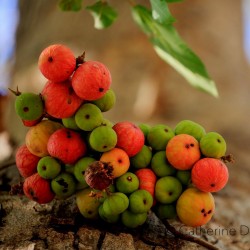
Cluster fig Seeds (Ficus...
Ár
2,10 €
(SKU: V 19 FR)
Seeds Gallery EU,
5/
5
<h2 class=""><strong>Cluster fig Seeds (Ficus racemose)</strong></h2>
<h2><span style="color: #ff0000;"><strong>Price for Package of 10 seeds.</strong></span></h2>
<p>Ficus racemosa (syn. Ficus glomerata Roxb.) is a species of plant in the family Moraceae. Popularly known as the cluster fig tree, Indian fig tree or goolar (gular) fig, this is native to Australia, Malesia, Indo-China, and the Indian subcontinent. It is unusual in that its figs grow on or close to the tree trunk, termed cauliflory. In India, the tree and its fruit are called gular in the north and atti in the south. The fruits are a favourite staple of the common Indian macaque. It serves as a food plant for the caterpillars of the two-brand crow butterfly (Euploea sylvester) of northern Australia.</p>
<p><strong>In Hinduism</strong></p>
<p>In the Atharva Veda, this fig tree (Sanskrit: uḍumbara or udumbara)[2] is given prominence as a means for acquiring prosperity and vanquishing foes.[3] For instance, regarding an amulet of the udumbara tree, a hymn (AV xix,31) extols:</p>
<p>The Lord of amulets art thou, most mighty: in the wealth's</p>
<p>ruler that engendered riches,</p>
<p>These gains are lodged in the, and all great treasures. Amulet,</p>
<p>conquer thou: far from us banish malignity and indigence,</p>
<p>and hunger.</p>
<p>Vigour art thou, in me do thou plant vigour: riches art thou, so</p>
<p>do thou grant me riches.</p>
<p>Plenty art thou, so prosper me with plenty: House-holder, hear</p>
<p>a householder's petition.[4]</p>
<p>It has been described in the story of Raja Harischandra of the Ikshvaku dynasty, that the crown was a branch of this udumbura tree, set in a circlet of gold. Additionally, the throne (simhasana) was constructed out of this wood and the royal personage would ascend it on his knee, chanting to the gods to ascend it with him, which they did so, albeit unseen. Its leaves are an indispensable part of many Hindu havans.</p>
<p><strong>In Buddhism</strong></p>
<p>Both the tree and the flower are referred to as the udumbara (Sanskrit, Pali; Devanagari: उडुम्बर) in Buddhism.[5] Udumbara can also refer to the blue lotus (nila-udumbara, "blue udumbara") flower. The udumbara flower appears in chapters 2 and 27 of the Lotus Sutra, an important Mahayana Buddhist text. The Japanese word udon-ge (優曇華, literally "udon/udumbara flower") was used by Dōgen Zenji to refer to the flower of the udumbara tree in chapter 68 of the Shōbōgenzō ("Treasury of the Eye of the True Dharma"). Dōgen places the udonge in the context of the Flower Sermon given by Gautama Buddha on Vulture Peak. Udonge is also used to refer to the eggs of the lacewing insect. The eggs are laid in a pattern similar to a flower, and its shape is used for divination in Asian fortune telling.</p>
<p>In Theravada Buddhism, the plant is said to have used as the tree for achieved enlightenment (bodhi) by the 26th Lord Buddha, Konaagama (Sinhala: කෝණාගම).</p>
<p><strong>Uses</strong></p>
<p>The Ovambo people call the fruit of the cluster fig eenghwiyu and use it to distill ombike, their traditional liquor.</p>
<p><strong>Health uses</strong></p>
<p>The bark of audumbar (oudumbar) tree is said to have healing power. In countries like India, the bark is rubbed on a stone with water to make a paste, which can be applied over afflicted by boils or mosquito bites. Allow the paste to dry on the skin and reapply after a few hours. For people whose skin is especially sensitive to insect bites, this is a very simple home remedy.</p><script src="//cdn.public.n1ed.com/G3OMDFLT/widgets.js"></script>
V 19 FR (10 S)


Ayurveda növény

Gyógy vagy fűszernövény
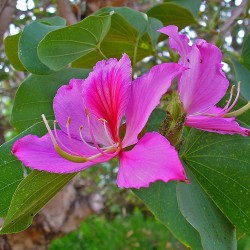
Közönséges orchideafa mag...
Ár
1,25 €
(SKU: T 91)
Seeds Gallery EU,
5/
5
<h2 class=""><strong>Közönséges orchideafa mag (Bauhinia variegata)</strong></h2>
<h2><span style="color: #f80000;"><strong>Az ár 5 mag csomagra vonatkozik.</strong></span></h2>
<p style="color: #202122; font-size: 14px;">A Bauhinia variegata virágos növényfaj a hüvelyesek, a Fabaceae családba. Kínától Délkelet-Ázsián át az indiai szubkontinensen egy olyan területen honos. A közönséges nevek közé tartozik az orchideafa (bár nem tartozik az Orchidaceae családhoz) és a hegyi ében.<br><br>Ez egy kis és közepes méretű fa, amely 10–12 méter magasra nő, száraz évszakban lombhullató. A levelek 10–20 centiméter (3,9–7,9 hüvelyk) alakúak, hosszúak és szélesek, lekerekítettek, az alján és a csúcsán kétgömbösek. A virágok szembetűnőek, élénk rózsaszínűek vagy fehérek, átmérőjük 8–12 centiméter (5,1–4,7 hüvelyk), öt szirommal. A pollenek hosszúkásak, körülbelül 75 mikron hosszúak.<br><br>A gyümölcs 15–30 centiméter (5,9–11,8 hüvelyk) hosszú mag, több magot tartalmaz. A magmag teljesen kiszárad a fán, és amikor az érett hélix vagy dugóhúzó alakúra csavarodni kezd (lásd alább), végül nyitva robbant fel - nagyon hallható "pattintással" -, hogy magjait a környezetbe juttassa.<br><br>Termesztésben<br><br>Ez egy nagyon népszerű díszfa fa szubtrópusi és trópusi éghajlaton, illatos virágai miatt termesztik, és az indiai konyhában élelmiszerként is használják. A Neotropics-ban a kolibri - például zafírpofás smaragd (Amazilia lactea), csillogó hasú smaragd (Chlorostilbon lucidus) vagy fehértorkú kolibri (Leucochloris albicollis) - kertekbe és parkokba vonzására használható. Másrészt egyes területeken honosított és invazívvá vált.<br><br>Használ<br><br>A Kachnar egy helyi név az indiai szubkontinensen a fáról gyűjtött ehető rügyekről; széles körben használják szubkontinens receptek összetevőjeként. A hagyományos kachnar curry kachnar rügyek, joghurt, hagyma és natív fűszerek felhasználásával készül. A kachnari rügyeket keverés közben sült zöldségként is fogyasztják, és az indiai szubkontinens sok részén achaárt, savanyúságot készítenek belőlük. Jó antioxidáns és rákellenes aktivitást mutat.<br><br>Hogyan csírázik?<br>Könnyen. A magokat, amelyeket 24 órán át friss szobahőmérsékletű vízben tartott, vetje be a nedves, tofával töltött edénybe, háromszor mélyebbre, mint a vetőmag, és öntse meg. Várja meg, amíg csírázik, a talajt nedvesen tartva meleg környezetben, közvetlen napsütés nélkül, amíg a csírázás meg nem történik. Megfelelő körülmények között a csírázás 21-30 nap múlva mindenképpen megtörténik. A csírázási hőmérséklet 18-22 fok között alakul. Kerülje a magasabb vagy alacsonyabb hőmérsékleteket.<br><br>* Ha egy kis lyukat készít a héjban azáltal, hogy a vetőmag egyik oldalán bevágást készít, hogy a mag könnyen felszívja a vizet, miközben a vízben várakozik, a dolgok gyorsabbá és könnyebbé válnak.<br><br>Gondozás és egyéb információk<br>Könnyen alkalmazkodhat sok talajtípushoz. A teljes napsütéstől félárnyékig ültetik a régiónak megfelelően. Növekedhet agyagos és meszes talajokban. Olyan talajokban fejlődik ki, amelyek pH-értéke semleges közeli, és savanyúvá válik lúgossá, ideális esetben 6-8 Ph-nál.<br><br>Hol termesztik?<br>Könnyű fagyálló kültéri növény. Alkalmas bonsai alkalmazásokhoz. Mérsékelt növekedést mutat.</p>
<script src="//cdn.public.n1ed.com/G3OMDFLT/widgets.js"></script>
T 91 (5 S)

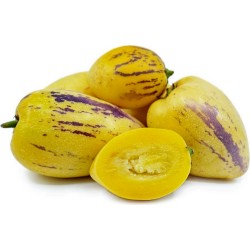
Pepino Dulce, Melon Pear...
Ár
2,95 €
(SKU: V 59)
Seeds Gallery EU,
5/
5
<h2><span style="font-size: 14pt;" class=""><strong>Pepino Dulce, Melon Pear Seeds (Solanum muricatum)</strong></span></h2>
<h3><span style="color: #ff0000; font-size: 14pt;"><strong>Price for Package of 5 seeds.</strong></span></h3>
<p>Solanum muricatum is a species of evergreen shrub native to South America and grown for its sweet edible fruit.</p>
<p>It is known as pepino dulce ("sweet pepino") or simply pepino; the latter is also used for similar species such as "S. mucronatum" (which actually seems to belong in the related genus Lycianthes). The pepino dulce fruit resembles a melon (Cucumis melo) in color, and its flavor recalls a succulent mixture of honeydew and cucumber, and thus it is also sometimes called pepino melon or melon pear, but pepinos are only very distantly related to melons and pears. Another common name, "tree melon", is more often used for the Papaya (Carica papaya) and the pepino dulce plant does generally not look much like a tree. The present species is, however, a close relative of other nightshades cultivated for their fruit, including the tomato (S. lycopersicum) and the eggplant (S. melongena), which its own fruit closely resembles.</p>
<p>The fruit is common in markets in Colombia, Ecuador, Bolivia, Peru and Chile, but less often overseas because it is quite sensitive to handling and does not travel well. Attempts to produce commercial cultivars and to export the fruit have been made in New Zealand, Turkey and Chile.</p>
<p><strong>Distribution and habitat</strong></p>
<p>The pepino dulce is presumed to be native to the temperate Andean regions of Colombia, Peru and Chile, though it is not known in the wild and the details of its domestication are unknown.Thepepino is a domesticated native of the Andes.</p>
<p><strong>Cultivation</strong></p>
<p>Moche clay vessel with pepino decoration (Larco Museum)</p>
<p>Pepinos are not often found archaeologically as they are soft and pulpy and not easy to preserve, while their tough seeds are small and easily lost among debris. But they were already described by early Spanish chroniclers as being cultivated on the coast; the Moche Valley in Peru was particularly famous for them. They were a popular decorative motif in Moche art.</p>
<p>In the United States the fruit is known to have been grown in San Diego before 1889 and in Santa Barbara by 1897. More commercially viable cultivars were introduced from New Zealand and elsewhere towards the end of the 20th century, leading to its introduction into up-scale markets in Japan, Europe and North America.</p>
<p>The pepino dulce is relatively hardy. In its native range it grows at altitudes ranging from close to sea level up to 3,000 m (10,000 ft.). However, it performs best in a warm, relatively frost-free climate. The plant can survive a low temperature of -2.5°C (27 to 28°F) if the freeze is not prolonged, though it may drop many of its leaves.[2] The species is a perennial, but its sensitivity to chilling, pests, and diseases force the growers to replant the crop every year. The crop also adapts well to greenhouse cultivation, training the plants up to 2 m tall, and obtaining yields that are 2-3 times larger than those obtained outdoors.</p>
<p>They are propagated by cuttings since they are established easily without rooting hormones. It is grown in a manner similar to its relatives such as the tomato, though it grows naturally upright by habit and can thus be cultivated as a free-standing bush, though it is sometimes pruned on trellises. Additionally, supports are sometimes used to keep the weight of the fruit from pulling the plant down. It has a fast growth rate and bears fruit within 4 to 6 months after planting. It is a perennial, but is usually cultivated as an annual. Seedlings are intolerant of weeds, but it can later easily compete with low growing weeds. Like their relatives tomatoes, eggplants, tomatillos and tamarillos, pepinos are extremely attractive to beetles, aphids, white flies and spider mites. Pepinos are tolerant of most soil types, but require constant moisture for good fruit production. Established bushes show some tolerance to drought stress, but this typically affects yield. The plants are parthenocarpic, meaning it needs no pollination to set fruit, though pollination will encourage fruiting.</p>
<p><strong>Ripe pepinos</strong></p>
<p>The plant is grown primarily in Chile, New Zealand and Western Australia. In Chile, more than 400 hectares are planted in the Longotoma Valley with an increasing proportion of the harvest being exported. Colombia, Peru, and Ecuador also grow the plant, but on a more local scale. Outside of the Andean region, it been grown in various countries of Central America, Morocco, Spain, Israel, and the highlands of Kenya. In the United States several hundred hectares of the fruit are grown on a small scale in Hawaii and California. More commercially viable cultivars have been introduced from New Zealand and elsewhere in more recent times. As a result, the fruit has been introduced into up-scale markets in Japan, Europe and North America and it is slowly becoming less obscure outside of South America. Delicate and mild-flavored, pepinos are often eaten as a fresh snack fruit, though they combine very well with a number of other fruits as well.</p>
<p>The study of the molecular variation of this pepino is of interest for several reasons. Although the seeds of pepino plants are fertile and produce vigorous offspring, this crop is primarily propagated by cuttings (Heiser, 1964; Anderson, 1979; Morley-Bunker, 1983), and as a consequence, its genetic structure could be different from that of seed-propagated crops.</p>
<script src="//cdn.public.n1ed.com/G3OMDFLT/widgets.js"></script>
V 59 5S


A növény ellenáll a hidegnek és a fagynak
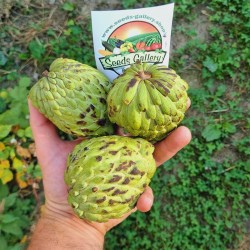
Atemoya magok (Annona ×...
Ár
5,95 €
(SKU: V 10 AAC)
Seeds Gallery EU,
5/
5
<h2><strong>Atemoya magok (Annona × cherimoya)</strong></h2>
<h2><span style="color: #f80000;"><strong>Ár csomag 3 magot.</strong></span></h2>
Az atemoya, Annona × cherimoya vagy Annona squamosa × Annona cherimola két gyümölcs - a cukor-alma (Annona squamosa) és a cherimoya (Annona cherimola) - hibridje, amelyek egyaránt az amerikai trópusokon honosak. Ez a gyümölcs népszerű Tajvanon, ahol "ananászcukor-almának" (鳳梨 釋迦) nevezik, ezért néha tévesen úgy gondolják, hogy a cukor-alma és az ananász kereszteződése. Kubában anón néven, Venezuelában pedig chirimorinon néven ismert. Izraelben és Libanonban a gyümölcsöt achta-nak hívják, Izraelben azonban gyakoribb Annonát latinnak nevezni. Tanzániában stafeli dogónak ("mini soursop") hívják. Brazíliában az atemoya népszerűvé vált, és 2011-ben Brazíliában mintegy 1200 hektár atemoia termesztett.<br><br>Az atemoya általában szív alakú vagy lekerekített, halványzöld, könnyen zúzódó, rögös bőrrel rendelkezik. A szár közelében a bőr göröngyös, mint a cukor-almában, de simábbá válik, mint az alsó cherimoya. A hús nem tagolt, mint a cukor alma, nagyobb hasonlóságot mutat a cherimoyaéval. Nagyon lédús és sima, kissé édes és kissé fanyar ízű, a piña coladára emlékeztet. Az íze a vaníliára is hasonlít cukor-alma szülőjéből. [3] Számos ehetetlen, mérgező, fekete mag található az atemoya húsában. [4] Érett állapotában a gyümölcs kihúzható a héjból, és hűtve fogyasztható.<br><br>Az Atemoya-t (Annona cherimola × squamosa) a cherimoya (A. cherimola) cukor-almával (A. squamosa) való keresztezésével fejlesztették ki. Természetes hibrideket találtak Venezuelában, és az 1930-as és 1940-es években véletlenszerű hibrideket figyeltek meg a szomszédos cukor alma- és cherimoya ligetekben Izraelben. [5]<br><br>Az első keresztet P.J. Wester, az USDA szubtrópusi laboratóriumának kertész kertésze tette meg 1908-ban. Az így kapott gyümölcsök kiváló minőségűek voltak, mint a cukor-alma, és az "atemoya" nevet kapták, az ate kombinációját, a cukor-alma régi mexikói elnevezését és a cserimoi "moya" nevet. Ezt követően, 1917-ben, Edward Simmons a miami Plant Introduction Station-nél sikeresen termesztett hibrideket, amelyek túlélték a hőmérséklet -3,1 ° C-ra történő csökkenését, megmutatva az atemoya szívósságát egyik szülőjétől, a cherimoyától.<br><br>Az atemoya, hasonlóan a többi annonai fához, protognikus, hermafrodita virágokat hordoz, és az önporzás ritka. Ezért a mesterséges kézi beporzás szinte mindig garantálja a kiváló minőségű gyümölcsöket. Az egyik fajta, a „Geffner”, kézi beporzás nélkül is jól termel. A „Bradley” szép növényeket is termel kézi beporzás nélkül, de a gyümölcs szokása, hogy hasít a fára. [6] Az atemoyák néha elfajultak, egyik oldalon fejletlenek, a nem megfelelő beporzás következtében.<br><br>Női szakaszában egy atemoya virág 14:00 és 16:00 óra között nyílik; a következő délután 15:00 és 17:00 óra között a virág hím szakaszába tér át.<script src="//cdn.public.n1ed.com/G3OMDFLT/widgets.js"></script>
V 10 AAC (3 S)

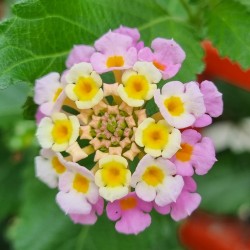
Sétányrózsa mag (Lantana...
Ár
1,95 €
(SKU: MHS 59)
Seeds Gallery EU,
5/
5
<h2 class=""><strong>Sétányrózsa mag (Lantana camara)</strong></h2>
<h2><span style="color: #f80000;"><strong>Ár egy csomag 10 magot.</strong></span></h2>
<p style="color: #202122; font-size: 14px;">A<span> </span><b>sétányrózsa</b><span> </span>vagy<span> </span><b>színváltóvirág</b><span> </span><i>(Lantana camara)</i><span> </span>a<span> </span>vasfűfélék<span> </span>vagy verbénafélék családjának<span> </span><i>Lantana</i><span> </span>nemzetségébe tartozó, dísznövényként hazánkban is terjedő örökzöld cserje.</p>
<h2 style="color: #000000; font-size: 1.5em;"><span class="mw-headline" id="Származása,_élőhelye">Származása, élőhelye</span></h2>
<p style="color: #202122; font-size: 14px;">Brazília trópusi-szubtrópusi tájainak gyomnövénye. Európába gyógyhatása miatt hozták be a spanyolok. Afrikába, Ausztráliába, Indiába dísznövényként került, de mára gyomként szaporodott el, a<span> </span>madarak<span> </span>gyorsan terjesztik magvait. Igen gyorsan terjed, a kiirtására tett próbálkozások sikertelennek bizonyultak, pedig sok fontos endemikus faj, köztük a<span> </span>szálafa<span> </span><i>(Shorea robusta)</i><span> </span>életlehetőségeit csökkenti.<sup id="cite_ref-1" class="reference">[1]</sup><span> </span>Sokféle hibridje ismert; ezek némelyike steril.</p>
<h2 style="color: #000000; font-size: 1.5em;"><span id="Tulajdons.C3.A1gai"></span><span class="mw-headline" id="Tulajdonságai">Tulajdonságai</span></h2>
<p style="color: #202122; font-size: 14px;">Többnyire 1–2 m magasra nő, de kaphatóak fácskának nevelt és bokros változai is. Metszéssel tetszőleges alakúvá nevelhető.</p>
<p style="color: #202122; font-size: 14px;">Gyökérrendszere erőteljes; gyorsan fejlődik.</p>
<p style="color: #202122; font-size: 14px;">Átellenes, egyesével álló redőzött, hosszúkás, sötétzöld levelei közvetlenül a sudár ágak mentén nőnek. A levelek és a hajtások is szőrösek. A hajtáscsúcsokon fejlődnek és késő tavasztól késő őszig nyílnak a<span> </span>verbénáéhoz<span> </span>hasonlító, domború virágzatok, amiket a pillangók és a méhek is igen kedvelnek. Mindegyik virág apró csöves és központi szemes. Levelei és virágai egyaránt átható, citromos illatot árasztanak.</p>
<p style="color: #202122; font-size: 14px;">Majdnem fekete, lilás-bordó bogyótermése éretlenül, zölden, mérgező. Legjellemzőbb mérgező alkaloidjai a<span> </span><b>lantadin A</b><span> </span>és<span> </span><b>B</b>. Az érett magok bordó színűek.</p>
<p style="color: #202122; font-size: 14px;">Számos növényt nem tűr meg a közelében (allelopata), de a rokon<span> </span>vasvirágokkal<span> </span>vagy a<span> </span>petúniákkal<span> </span>összeültethető. Sok rovart is elriaszt.</p>
<h2 style="color: #000000; font-size: 1.5em;"><span id="Termeszt.C3.A9se"></span><span class="mw-headline" id="Termesztése">Termesztése</span><span class="mw-editsection" style="font-size: small;"><span class="mw-editsection-bracket" style="color: #54595d;">[</span>szerkesztés<span class="mw-editsection-bracket" style="color: #54595d;">]</span></span></h2>
<div class="thumb tright" style="color: #202122; font-size: 14px;">
<div class="thumbinner" style="font-size: 13.16px;"><img alt="Sétányrózsa.jpg" src="https://upload.wikimedia.org/wikipedia/commons/thumb/1/17/S%C3%A9t%C3%A1nyr%C3%B3zsa.jpg/200px-S%C3%A9t%C3%A1nyr%C3%B3zsa.jpg" decoding="async" width="200" height="150" class="thumbimage" srcset="//upload.wikimedia.org/wikipedia/commons/thumb/1/17/S%C3%A9t%C3%A1nyr%C3%B3zsa.jpg/300px-S%C3%A9t%C3%A1nyr%C3%B3zsa.jpg 1.5x, //upload.wikimedia.org/wikipedia/commons/thumb/1/17/S%C3%A9t%C3%A1nyr%C3%B3zsa.jpg/400px-S%C3%A9t%C3%A1nyr%C3%B3zsa.jpg 2x" data-file-width="3264" data-file-height="2448">
<div class="thumbcaption" style="font-size: 12.3704px;">
<div class="magnify"></div>
</div>
</div>
</div>
<p style="color: #202122; font-size: 14px;">Könnyen nevelhető; szaporítása még a kezdő kertészkedőnek sem sem okoz gondot. Tarthatjuk cserépben, edényben, függőkosárban.</p>
<p style="color: #202122; font-size: 14px;">A talaj szerkezetéről szinte függetlenül jól fejlődik, de csak tápanyagdús környezetben virágzik gazdagon. Célszerű átlagos, jó vízgazdálkodású, semleges kémhatású (6,5–7<span> </span>pH) kerti földbe ültetni. Kedveli a tőzeget.</p>
<p style="color: #202122; font-size: 14px;">Fagyérzékeny, a szabadban nem telel át. Télen minimum 10–13 °C-t igényel. Mivel leveleit télen sem hullajtja le, ezért fontos, hogy világos helyen teleltessük, de ha ágait tövig visszavágjuk, levihetjük a pincébe is. Nyáron sok, de nem direkt fényre van szüksége. Akár az udvarra is kivihetjük, de a tűző, déli naptól védeni kell.</p>
<p style="color: #202122; font-size: 14px;">Télen ritkábban (havonta egyszer), tavasztól őszig rendszeresen öntözni kell (hetente tápoldattal is). Két öntözés között hagyni kell, hogy a földje kiszáradjon. A leveleit célszerű időnként permetezni. A szárazságot is tűri, de ilyenkor kevesebb virágot hoz.</p>
<p style="color: #202122; font-size: 14px;">Ha ez szükséges, a többi szobanövényhez hasonlóan tavasszal ültessük át. Ha májusig visszavágjuk hosszabb hajtásait, több virágot hoz. Ha elvirágzott, vágjuk vissza a szárait kb. a felére! A levágott darabokból hajtásdugványt készítve az év bármely szakában szaporítható. Ha törzses fácskát akarunk nevelni belőle, meg kell hagyni egy vezérágat, az oldalhajtásokat pedig félgömb alakban kell visszacsípni. Két-háromévenként a növényeket meg kell újítani, mert az idősebb példányok előbb-utóbb megcsúnyulnak.</p>
<p style="color: #202122; font-size: 14px;">Magjait kora tavasszal kell elvetni.</p>
<p style="color: #202122; font-size: 14px;">Olyankor, amikor nem virágzik, nem különösen mutatós: levelei ráncosak, a szára szúrós. Egész nyáron nyíló, kezdetben citromsárga, narancssárga, majd tűzvörös és végül lilásba forduló ernyővirágzata azonban kimondottan látványos. Fehér, halványlila, sötétpiros és rózsaszín virágú változata is van.</p>
<p style="color: #202122; font-size: 14px;">Az<span> </span>üvegházi molytetűre<span> </span>(liszteskére) nagyon érzékeny.</p>
<h2 style="color: #000000; font-size: 1.5em;"><span id="Gy.C3.B3gyhat.C3.A1sa.2C_haszn.C3.A1lata"></span><span class="mw-headline" id="Gyógyhatása,_használata">Gyógyhatása, használata</span></h2>
<p style="color: #202122; font-size: 14px;">Levelei összezúzva, borogatásként antiszeptikusak és csillapítják a fájdalmakat. Rovarcsípésekre, vágásokra, horzsolásokra jól alkalmazhatók. Főzetüket Mexikóban gyomorbántalmak ellen használják, másutt kígyómarást gyógyítanak vele. Teája reuma, megfázás, láz, torokfájás ellen hatékony. A levélforrázatot inhalálva légúti problémáinkat kezelhetjük. A száraz levelek füstje szúnyogriasztó.</p>
<p style="color: #202122; font-size: 14px;">Rokona, a<span> </span>kúszó sétányrózsa<span> </span><i>(Lantana montevidensis)</i><span> </span>ideális talajtakaró növény.</p>
<script src="//cdn.public.n1ed.com/G3OMDFLT/widgets.js"></script>
MHS 59 (10 S)


A növény ellenáll a hidegnek és a fagynak
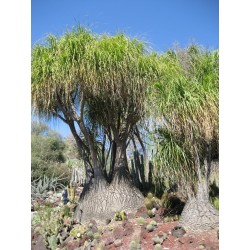
Pálma mag Közönséges...
Ár
1,95 €
(SKU: PS 15)
Seeds Gallery EU,
5/
5
<h2><strong>Pálma mag Közönséges elefántláb (Beaucarnea recurvata)</strong></h2>
<h2><span style="color: #f80000;"><strong>Ár egy csomag 2 magot.</strong></span></h2>
<p style="color: #202122; font-size: 14px;">A<span> </span><b>közönséges elefántláb</b><span> </span><i>(Beaucarnea recurvata)</i><span> </span>az<span> </span>egyszikűek<span> </span><i>(Liliopsida)</i><span> </span>osztályának<span> </span>spárgavirágúak<span> </span><i>(Asparagales)</i><span> </span>rendjébe, ezen belül a<span> </span>spárgafélék<span> </span><i>(Asparagaceae)</i><span> </span>családjába<span> </span>tartozó<span> </span>faj.</p>
<p>A közönséges elefántláb eredeti előfordulási területe<span> </span>Mexikóban<span> </span>található. A következő mexikói államokban van jelen:<span> </span>Oaxaca,<span> </span>Puebla,<span> </span>San Luis Potosí,<span> </span>Tamaulipas<span> </span>és<span> </span>Veracruz.</p>
<p>Érdekes kinézete miatt sokfelé közkedvelt dísznövény.</p>
<h2 style="color: #000000; font-size: 1.5em;"><span id="Megjelen.C3.A9se"></span><span class="mw-headline" id="Megjelenése">Megjelenése</span></h2>
<p>Ennek a kisebb faméretű - 4730 centiméter magas - spárgafélének a<span> </span>törzse<span> </span>alul, a talajszinten megvastagodott, feljebb haladva pedig szétágazik, több törzset alkotva. A hosszú és vékony<span> </span>levelei, az ágak végein csomókban helyezkednek el és lelógnak. A fehéres-sárga<span> </span>virágai<span> </span>virágzatokba<span> </span>tömörülnek és a levelek fölött szárakon helyezkednek el.</p>
<script src="//cdn.public.n1ed.com/G3OMDFLT/widgets.js"></script>
PS 15 (2 S)


A növény ellenáll a hidegnek és a fagynak
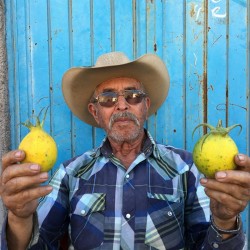
Jarilla magvak (Jarilla...
Ár
7,95 €
(SKU: V 72)
Seeds Gallery EU,
5/
5
<h2 class=""><strong>Jarilla magvak (Jarilla caudata)</strong></h2>
<h2><span style="color: #ff0a0a;"><strong>Ár egy csomag 3 magot.</strong></span></h2>
A Jarilla caudata meglehetősen látványos növény és papaya rokon, meglehetősen rendkívüli és rendkívül szokatlan gyümölcsökkel. Függőleges vagy kúszó, száraz lombhullató, lágyszárú évelő, Mexikóban és Közép -Amerikában őshonos, ahol xerofita cserjésekben és lombhullató erdőkben nő, 1500 és 2000 m közötti magasságban.<br><br>A Jarilla heterophylla-hoz hasonlóan zamatos gumót termel, amely zöld vagy lilás-zöld szárakat tartja, amelyek az aljától ovális, lándzsa alakú levelekkel és fehéres virágokkal, esetenként lila csíkokkal ágaznak el. A virágokat hosszúkás, ellipszis alakú gyümölcsök követik, amelyek akár 30 cm hosszúak is lehetnek, hosszú, szarvszerű nyúlványokkal. A zöld világosabb és sötétebb árnyalataiban foltosak, és éretten sárgulnak, míg a "szarvak" lilás színűek.<br><br>A gyümölcsök ehetők, és alkalmanként megtalálhatók a helyi piacokon. A lágy gyümölcsöket nyersen fogyasztják, míg a teljesen érett gyümölcsöket frissítő ital készítésére használják. Egy régi mexikói recept szerint a Jarilla caudata gyümölcsökből konzerveket is lehet készíteni, és különösen finomak, ha kókuszdióval kombinálják.<br><br>A papaja ezen rokona a legtöbb meleg mérsékelt éghajlaton eléri a legkevesebb USDA 9. zónát, és még bizonyos szárazságot és hideget is túlél. Érdekes faj lenne más papaya rokonokkal való hibridizációhoz.
<script src="//cdn.public.n1ed.com/G3OMDFLT/widgets.js"></script>
V 72 (3 S)





